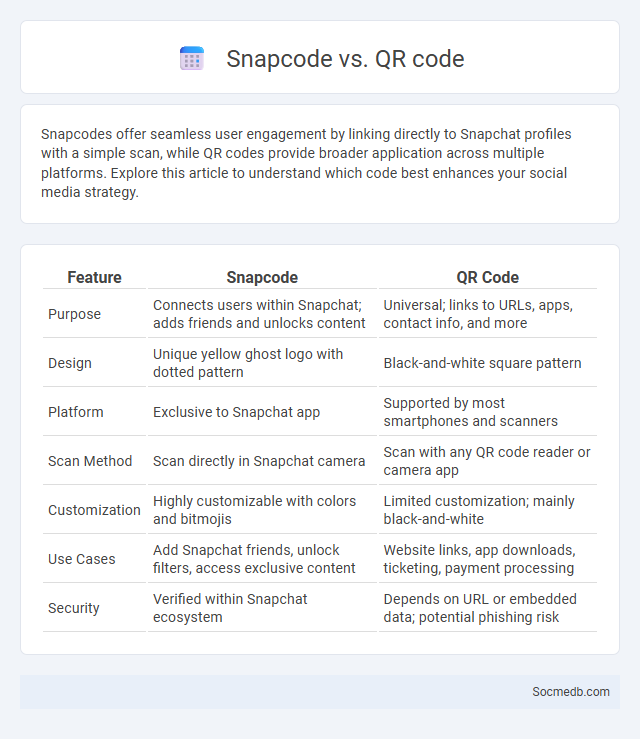
Photo illustration: Snapcode vs QR code
Snapcodes offer seamless user engagement by linking directly to Snapchat profiles with a simple scan, while QR codes provide broader application across multiple platforms. Explore this article to understand which code best enhances your social media strategy.
Table of Comparison
| Feature | Snapcode | QR Code |
|---|---|---|
| Purpose | Connects users within Snapchat; adds friends and unlocks content | Universal; links to URLs, apps, contact info, and more |
| Design | Unique yellow ghost logo with dotted pattern | Black-and-white square pattern |
| Platform | Exclusive to Snapchat app | Supported by most smartphones and scanners |
| Scan Method | Scan directly in Snapchat camera | Scan with any QR code reader or camera app |
| Customization | Highly customizable with colors and bitmojis | Limited customization; mainly black-and-white |
| Use Cases | Add Snapchat friends, unlock filters, access exclusive content | Website links, app downloads, ticketing, payment processing |
| Security | Verified within Snapchat ecosystem | Depends on URL or embedded data; potential phishing risk |
Introduction to Snapcode and QR Code
Snapcode is a unique, scannable code used within Snapchat that allows users to quickly add friends, unlock filters, and access exclusive content by simply scanning the code within the app. QR Code, a versatile matrix barcode, can store various types of data including URLs, contact information, and app links, making it a powerful tool for seamless interaction and marketing across multiple social media platforms. Both Snapcode and QR Code enhance user engagement by simplifying the process of connecting and sharing content in the digital social environment.
What is a Snapcode?
A Snapcode is a unique, scannable QR code used within Snapchat to quickly add friends, unlock filters, and access exclusive content. Each Snapcode consists of a distinctive yellow background with black dots surrounding the Snapchat ghost logo, enabling seamless connection and engagement. Users can generate and share Snapcodes to enhance social media interaction and simplify the process of expanding their Snapchat network.
What is a QR Code?
A QR code, or Quick Response code, is a two-dimensional barcode that stores digital information accessible via smartphone cameras or QR scanners. These codes can link to websites, social media profiles, contact details, or multimedia content, making them essential tools for marketing, social media engagement, and seamless offline-to-online interaction. Social media platforms leverage QR codes to simplify user connections, such as sharing profiles or joining groups quickly.
Snapcode vs QR Code: Key Differences
Snapcode and QR Code serve as efficient tools for quick access and sharing on social media platforms, but Snapcode is specifically designed for Snapchat, allowing users to add friends or unlock exclusive content with a simple scan. QR Codes offer broader compatibility across multiple apps and services, enabling versatile use cases such as directing users to websites, promotional offers, or social profiles beyond Snapchat's ecosystem. Understanding these differences helps you select the best digital tool to enhance your social media engagement and streamline user interaction.
Scanning Technology: How Snapcodes and QR Codes Work
Snapcodes and QR codes use scanning technology to instantly connect users to digital content by encoding data into a unique matrix or pattern readable by smartphone cameras. This data can include URLs, user profiles, or multimedia, enabling seamless social media interactions and marketing campaigns. The efficiency of Snapcodes and QR codes lies in their ability to quickly transfer information without manual input, enhancing user engagement and accessibility across platforms like Snapchat and Instagram.
Design and Customization: Visual Appeal Compared
Design and customization play a crucial role in enhancing the visual appeal of social media profiles, making them stand out in crowded digital spaces. Platforms like Instagram and Pinterest offer extensive design tools and templates that allow you to tailor your content's look to match your brand identity. By leveraging these customization features, your social media presence becomes more engaging and visually cohesive, attracting and retaining followers more effectively.
User Experience: Ease of Use and Accessibility
Social media platforms prioritize user experience by offering intuitive interfaces that simplify navigation and content sharing, ensuring users can effortlessly connect and engage. Accessibility features like screen reader compatibility, adjustable text sizes, and voice commands address diverse needs, making social media inclusive for individuals with disabilities. Enhancing ease of use and accessibility directly improves Your ability to communicate and enjoy seamless interactions across various devices and network environments.
Security and Privacy: Which Is Safer?
Social media platforms implement various security measures, such as end-to-end encryption and two-factor authentication, to protect user data, yet privacy risks remain due to frequent data breaches and unauthorized third-party access. Users face challenges in maintaining privacy because platforms often collect extensive personal information for targeted advertising and data analytics. Choosing the safest social media app depends on the platform's transparency, privacy policies, and how effectively it enforces user data protection regulations.
Popular Use Cases: Snapcodes vs QR Codes
Snapcodes offer seamless user engagement by enabling quick access to Snapchat profiles, filters, and content through a simple camera scan, enhancing interactive experiences. QR codes provide versatile functionality across various platforms, supporting website URLs, payment processing, and promotional campaigns with broad device compatibility and easy customization. Both technologies drive user interaction, but Snapcodes specialize in social media integration, while QR codes serve multi-industry marketing and operational needs.
Which Code Should You Choose?
Selecting the right code for social media development depends on your project goals and platform compatibility. JavaScript frameworks like React and Angular offer dynamic user interfaces ideal for engaging content, while Python excels in backend automation and data analysis. Opt for Swift or Kotlin when building native mobile apps to ensure optimal performance and seamless user experience.
 socmedb.com
socmedb.com